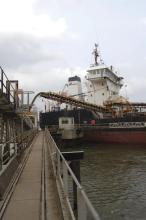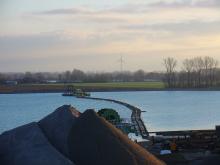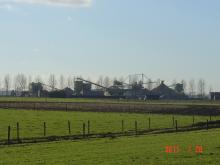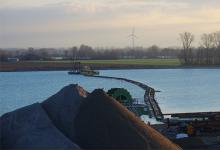
Enlargement of Rotterdam Harbour in the Netherlands will call for one of the largest marine aggregates extraction sites in Europe. Ad Stolk from the Netherlands' Rijkswaterstaat (
Marine aggregates form a vital source of sand for many construction markets in Europe, but in the Netherlands much of the material extracted is not used for concrete production. The Netherlands' current annual 42 million tonnes extraction is mainly used for coastal nourishment and fill but a new project is set to increase this total significantly.
Excavation work on one of the latest marine aggregates projects in the Netherlands will not only allow a new development to go ahead, it will also provide the material to create the land it needs. The project is an extension of Rotterdam's harbour to provide both new dockside area and also a larger deep draft area to allow large ships to use the new facilities.
The enlargement of the new harbour area, which is known as Maasvlakte 2, will include reclamation of 20 km² which is needed. Half of this area will be used for harbour related activities such as container terminals, distribution of goods and chemical industries. All of these activities need a deep water harbour and excavation of the material to reclaim the dockside area will create a 20m deep draft for the harbour. The other half of the reclaimed land will be used for dykes, access roads and harbour basins.
Work on construction is planned to start in the second half of 2008 and the new facility is expected to be operational from 2013 onwards. To complete the reclamation, around 365million cubic meters of marine sand will be needed. This is about fifteen times the current annual extraction level of marine sand by the Netherlands from the North Sea.
Marine resources
Most coastal countries in north western Europe and the Baltic region are involved in the extraction of marine sand and gravel. Large amounts of marine sediments are extracted by the UK, the Netherlands and Denmark but the approach taken by each country to granting permission for extraction is different.
Extraction of marine sand has an effect on the sea bed and its fauna and it takes several years before total recovery of the fauna is reached. The international Working Group on the effects of extraction of marine sediments on the marine ecosystem (WGEXT) of the
In the Netherlands, these guidelines are taken into account for the licensing of marine sand extraction in the North Sea. The extraction of marine sand and gravel is subject to regulations to ensure recovery of benthic fauna and to avoid negative influence on coastal defences and other use of the sea. The most important restriction is that extraction is not allowed in an area along the coast where the water depth is less than 20 metres, both for ecological and coastal defence reasons.
Studies are executed to determine the ecological and morphological effects of extraction and some criteria are usually given to minimise the impact. The aim after large scale extraction is for the sediments of the new sea bed not to differ too much from the original sediments. The pit must also be designed so that the water exchange near the bottom of the pit is sufficient to ensure that there will be no oxygen depletion. Additionally, the extraction should have minimal influence on other uses of the sea.
Rotterdam
The construction of Maasvlakte 2 is a large project that will have a major impact on the natural and industrial environment. Development of the project has required a lot of communication between governmental authorities, the harbour company, non-governmental organisations and the general public.
Licenses are required for the reclamation of a sea area, for the seawall construction and for the extraction of sand, as well as to meet the Netherlands' nature laws. Although work on site is only just about to start, work on the project development started more than 10 years ago.
The driving factor behind the project is to provide more space for Rotterdam harbour. In addition to the enlargement, the existing harbour will be rearranged and a nature area of 750ha is also planned. This last project is needed because there is an agreement in the region that every major action for economic purposes should have a counter action for nature and communities in the region.
The enlargement of the Rotterdam harbour is planned in a Natura 2000 area and to compensate for the lost 20km2 of shallow sea habitat, improvements to 200km2 are planned in another part of the Natura 2000 area. Here strong restrictions will be enforced on bottom disturbing activities like fishing and extraction of shells. The EU requires that the compensation is arranged before the work on the enlargement of the harbour starts, so a management plan to formally regulate the measures is made.
Sand extraction
Material for Maasvlakte 2 will be extracted in an area outside the 20m depth contour. Moreover, when the sand is extracted from areas where the seabed contains little mud, the effects on the ecology of the coastal zone are limited. However areas that contain too much mud or even clay layers are excluded from the Maasvlakte 2 extraction plan.
The direct elimination of benthic fauna can be decreased by the construction of extraction pits deeper than the usual two metre depth beneath the seabed. A larger extraction depth leads to a lesser area to be disrupted by the hopper dredgers. Extraction pits will have a mean depth of 10m, although a local maximum of 20m is allowed. The total area for the extraction of marine sand will be restricted to 60 km2.
By design, pits will not have steep sloping sides to allow the oxygen rich seawater to reach the bottom of the pit and enable benthic fauna to re-colonise the area in several years. Negative effects on the coastal defence are not expected from an extraction so far from the coast.
Impact assessment
For the coastal area the enlargement of Rotterdam harbour is a large intervention but an in-depth environmental impact assessment (EIA) - running to 6000 pages - has been carried out. The assessment included looking at the effects of the project on morphology and water movement off the coast, on ecology and nature, on other activities at sea and on archaeological values.
A public consultation of the EIA was carried out in spring 2007 and an independent Committee for Environmental Impact Assessments also gave formal advice on the project. With the information from the EIA and the reactions and advice, the government has formulated their concept licences. The concept licenses were published for public consultation in January 2008 with definite licenses planned for this summer, which will give the green light for construction to get underway









